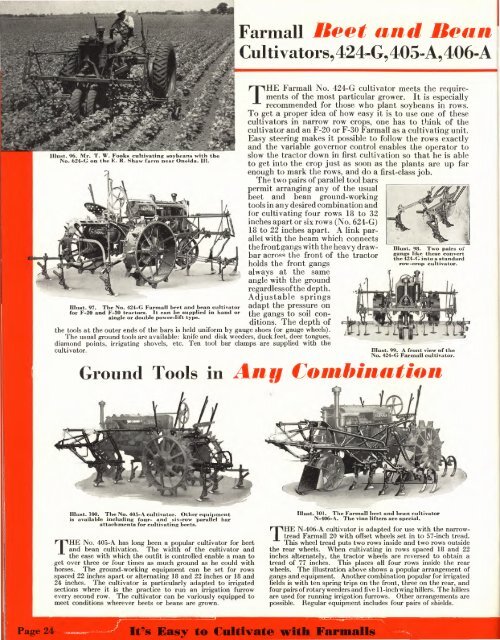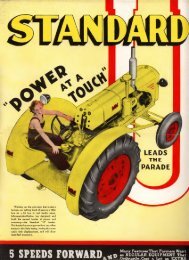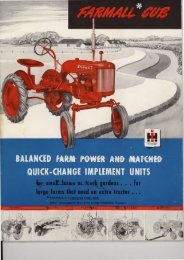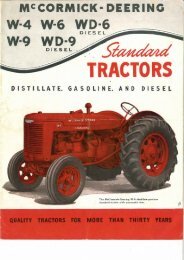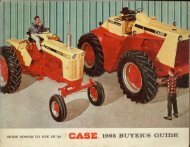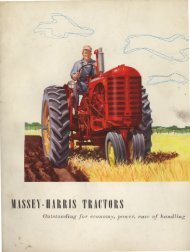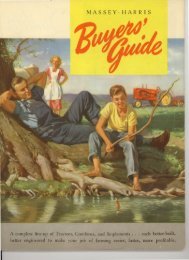McCormick-Deering Farmall Tractors and ... - Antique Farming
McCormick-Deering Farmall Tractors and ... - Antique Farming
McCormick-Deering Farmall Tractors and ... - Antique Farming
You also want an ePaper? Increase the reach of your titles
YUMPU automatically turns print PDFs into web optimized ePapers that Google loves.
Illust. 96. Mr. T. W. Fooks cultivating soybeans with the<br />
No. 624-G on the E. II. Shaw farm near Oneida, Ill.<br />
<strong>Farmall</strong> Beet <strong>and</strong> Beanl<br />
Cultivators, 424-G, 405-A, 406-A<br />
THE <strong>Farmall</strong> No. 424-G cultivator meets the requirements<br />
of the most particular grower. It is especially<br />
recommended for those who plant soybeans in rows.<br />
To get a proper idea of how easy it is to use one of these<br />
cultivators in narrow row crops, one has to think of the<br />
cultivator <strong>and</strong> an F-20 or F-30 <strong>Farmall</strong> as a cultivating unit.<br />
Easy steering makes it possible to follow the rows exactly<br />
<strong>and</strong> the variable governor control enables the operator to<br />
slow the tractor down in first cultivation so that he is able<br />
to get into the crop just as soon as the plants are up far<br />
enough to mark the rows, <strong>and</strong> do a first-class job.<br />
The two pairs of parallel tool bars<br />
permit arranging any of the usual<br />
beet <strong>and</strong> bean ground-working<br />
tools in any desired combination <strong>and</strong><br />
for cultivating four rows 18 to 32<br />
inches apart or six rows (No. 624-G)<br />
18 to 22 inches apart. A link parallel<br />
with the beam which connects<br />
the front gangs with the heavy drawbar<br />
across the front of the tractor<br />
holds the front gangs<br />
always at the same<br />
angle with the ground<br />
regardless of the depth.<br />
Adjustable springs<br />
Illust. 97. The No. 424-G <strong>Farmall</strong> beet <strong>and</strong> bean cultivator adapt the pressure on<br />
for F-20 <strong>and</strong> F-30 tractors. It can he supplied in h<strong>and</strong> or<br />
single or double power-lift type.<br />
the gangs to soil conditions.<br />
The depth of<br />
the tools at the outer ends of the bars is held uniform by gauge shoes (or gauge wheels).<br />
The usual ground tools are available: knife <strong>and</strong> disk weeders, duck feet, deer tongues,<br />
diamond points, irrigating shovels, etc. Ten tool bar clamps are supplied with the<br />
cultivator.<br />
Illust. 98. Two pairs of<br />
gangs like these convert<br />
the 424-G into a st<strong>and</strong>ard<br />
row-crop cultivator.<br />
Illust. 99. A front view of the<br />
No. 424-G <strong>Farmall</strong> cultivator.<br />
Ground Tools in Any Combination<br />
Illust. 100. The No. 405-A cultivator. Other equipment<br />
is available including four- <strong>and</strong> six-row parallel bar<br />
attachments for cultivating beets.<br />
THE No. 405-A has long been a popular cultivator for beet<br />
<strong>and</strong> bean cultivation. The width of the cultivator <strong>and</strong><br />
the ease with which the outfit is controlled enable a man to<br />
get over three or four times as much ground as he could with<br />
horses. The ground-working equipment can be set for rows<br />
spaced 22 inches apart or alternating 18 <strong>and</strong> 22 inches or 18 <strong>and</strong><br />
24 inches. The cultivator is particularly adapted to irrigated<br />
sections where it is the practice to run an irrigation furrow<br />
every second row. The cultivator can be variously equipped to<br />
meet conditions wherever beets or beans are grown.<br />
Illust. 101. The <strong>Farmall</strong> beet <strong>and</strong> bean cultivator<br />
N-406-A. The vine lifters are special.<br />
THE N-406-A cultivator is adapted for use with the narrowtread<br />
<strong>Farmall</strong> 20 with offset wheels set in to 57-inch tread.<br />
This wheel tread puts two rows inside <strong>and</strong> two rows outside<br />
the rear wheels. When cultivating in rows spaced 18 <strong>and</strong> 22<br />
inches alternately, the tractor wheels are reversed to obtain a<br />
tread of 77 inches. This places all four rows inside the rear<br />
wheels. The illustration above shows a popular arrangement of<br />
gangs <strong>and</strong> equipment. Another combination popular for irrigated<br />
fields is with ten spring trips on the front, three on the rear, <strong>and</strong><br />
four pairs of rotary weeders <strong>and</strong> five 11-inch wing hillers. The hillers<br />
are used for running irrigation furrows. Other arrangements are<br />
possible. Regular equipment includes four pairs of shields.<br />
---,-<br />
Page 2 . It's Easy to Cultivate with <strong>Farmall</strong>s


